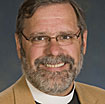On the one hand you’ve got the world presented in the Bible reading; on the other you’ve got the new, living context into which the sermon will be preached. What connects those two worlds?
We gladly affirm that God, Jesus, Spirit, and the church are continuous characters alive in both worlds. But unless we wish to relegate to merely historical interest all the rest of the characters and situations we encounter in the Bible, we look to the preacher to name for us how those things back then refer to things here and now.
Often we reach for traditional (nearly default) identifications: Israelites or disciples or the members of the church in Galatia equal the contemporary church; Jerusalem or Rome equals Washington; Pharisees equal self-righteous–usually other–Christians. But analogical connections between text and world have the power, through confirmation, disruption, or playfulness, to accomplish a variety of theological, drickle, educational, pastoral, moral, missional, or aesthetic goals. And so sometime we are inspired by the preaching context to stipulate fresh and surprising identifications: last time we were the missional Samaritan looking for stranded motorists; the time before that we confronted our own distractedness by identifying with the Levite; but this time the economy has us feeling pretty beaten and we are looking up from the ditch for a neighbor–any neighbor.
It was a moment of cultural reorientation that I heard Stephen Farris suggest when entering Psalm 137, middle-class European-Americans ought to ponder how their side of the river is not with the mournful Israelites but with the Babylonians who so enjoy the minstrel shows of oppressed minority cultures. Two things struck me: the first was the tenacity of my preference for the default identification (Israel=Church=me!). The second was how quickly the aptness of the new, disturbing analogy began to work on my worldview.
We are all gifted with the imagination to see analogies and identifications…and we can get better at it. In their book Mental Leaps: Analogy in Creative Thought, Keith Holyoak and Paul Thagard take a comprehensive look at how analogy works. While their concerns and not theological, I have found one of their simple schemes helpful in considering how I move from Bible to world. Holyoak and Thagard line out a three level scheme of analogical relationships: simple attributes (noun with adjective or adjectives); simple relationships (noun verb object); and complex systems of relationships. While there are powerful analogical possibilities at all three levels, the most satisfying analogies are those with a web of connections.
For example, consider the story of David and Goliath. The scheme might unfold in this way. At the level of simple attributes, we could say that, “David was a youth called (by God).” At this point, we have the theme for a possible, but singularly unsatisfying, confirmation sermon: “you kids are just like David: called by God!”
At the level of simple relationships, we might say, “David, empowered by trust in God, conquered something bigger than himself.” Perhaps now, David emerges as a model for us as we face big issues in our lives. But, if the attributes of the “bigger thing” are unspecified, we might end up naming salutary challenges as “Goliath” (so that the congregation’s building program becomes the monster from Gath…oops!). To work, the sermon will have to frame out Goliath’s “evil” attributes. It might work.
Finally, at the level of complex systems (and here I have chosen just a handful, many more could be gleaned from the text): David is singularly small and fearless; David’s weapons seem inadequate; David rejects the customary tools of warfare (Saul’s armor); Goliath is pagan; Goliath derides all that David stands for; and yet David succeeds using his inadequate tools. From here, we might move to a sermon about the Church’s challenge in responding with humility and non-combativeness to the onslaught of media messages from militant atheism; or perhaps the preacher can name the smooth stone we might fling to disable the juggernaut of policies that steamroll the poor.
All three (and a hundred more!) sermons are possible.
This scheme helps me stay focused on the Bible-to-world analogies as they take shape in my imagination, increasing the chance that I will spot where simple attributes and relationships are not rich enough or do not match up so that I can move into analogies that exploit more complex relationships. All analogies break down eventually; so a part of sermon composition will always be framing analogies so that elements that do not match up can be kept at bay. This I accept as the inevitable result of the ambiguity of communication.

